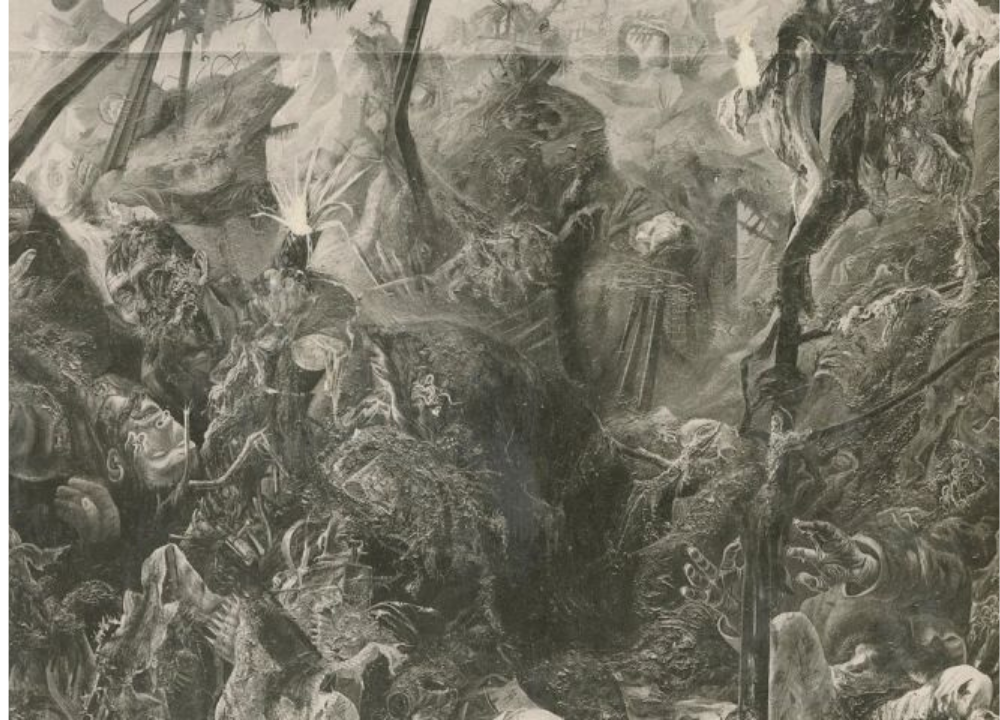Otto Dix is renowned for his mastery of Expressionist Realism in his artworks. His unique style and technique have made him a significant figure in the art world.
Born in Germany in 1891, Dix’s experiences as a soldier in World War I greatly influenced his art, leading to a focus on the harsh realities of war and the human condition. His powerful and raw depictions of the post-war society, characterized by social and political upheaval, further cemented his reputation as a leading figure in the Expressionist movement.
Through his use of bold colors, distorted figures, and intense emotions, Dix’s art captures the essence of the time period and continues to resonate with audiences today. His legacy as the Master of Expressionist Realism lives on through his impactful and thought-provoking works.
Early Life And Influences
Otto Dix, renowned for his mastery of Expressionist Realism, was a German painter and printmaker whose work vividly captured the tumultuous interwar period. His art reflects a blend of social critique, psychological depth, and raw emotion, earning him the reputation as a master of his craft. Exploring Dix’s early life and influences provides valuable insight into the formation of his artistic vision and the events that shaped his unique perspective.
Family Background
Coming from a modest background, Otto Dix was born on December 2, 1891, in Untermhaus, a small town in central Germany. His father, Franz Dix, was an iron foundry worker, and his mother, Louise, a seamstress. Growing up in an environment marked by industrial labor and frugality, Dix’s early experiences instilled in him a deep sense of the realities faced by the working class. This upbringing greatly influenced his artistic themes, as he later depicted the struggles and hardships of everyday life in his works.
Artistic Inspirations
Dix’s exposure to the works of German Renaissance masters, such as Albrecht Dürer and Lucas Cranach the Elder, during his formative years left an indelible mark on his artistic development. Their attention to detail and portrayal of human anatomy significantly influenced Dix’s own meticulous approach to realism. Additionally, his experiences as a soldier in World War I profoundly impacted his artistic style, leading to a shift towards a more somber and critical outlook on society. The horrors of war and its aftermath became recurring motifs in his oeuvre, reflecting his disillusionment with the prevailing social and political order.
Evolution Of Style
Discover the evolution of style in the remarkable works of Otto Dix: The Master of Expressionist Realism. Otto Dix’s artistic journey is a testament to the dynamic shifts in style and technique that defined his career. Let’s delve into the transformative phases that shaped his unique approach to art.
Transition To Expressionism
Otto Dix underwent a significant artistic transformation as he embraced the tenets of Expressionism. Bold colors, distorted forms, and emotive brushwork became hallmarks of his work during this period. The transition marked a departure from traditional artistic norms, allowing Dix to convey raw emotions and societal critiques with unparalleled intensity.
Exploration Of Realism
While rooted in Expressionism, Otto Dix’s exploration of realism added a layer of depth and complexity to his art. Through meticulous attention to detail and a keen eye for capturing the essence of his subjects, Dix brought a sense of gritty reality to his paintings. His commitment to portraying the harsh truths of war, society, and human nature set him apart as a master of realism within the realm of Expressionist art.
Themes In Dix’s Art
In the art world, Otto Dix is celebrated as The Master of Expressionist Realism, known for his powerful and provocative works that delve into the darker aspects of society. Themes in Dix’s Art are deeply rooted in his experiences during and after World War I, showcasing a raw and unapologetic portrayal of the human condition.
War And Its Aftermath
One of the central themes in Dix’s art is the impact of war and its aftermath on individuals and society. His experiences as a soldier in World War I profoundly influenced his work, leading to haunting depictions of the brutality and devastation of war. Dix’s art captures the physical and psychological scars left by the conflict, shedding light on the harsh realities faced by soldiers and civilians alike.
Social Critique
Dix’s art also serves as a powerful form of social critique, challenging conventional norms and exposing the inequalities and injustices prevalent in society. Through his vivid and often grotesque imagery, Dix confronts issues such as poverty, corruption, and the dehumanizing effects of industrialization. His unflinching portrayal of the darker aspects of human nature forces viewers to confront uncomfortable truths and reflect on the complexities of the world around them.

Iconic Works
Otto Dix, a prominent figure in the German Expressionist movement, is renowned for his iconic works that depict the harsh realities of post-World War I Germany. His paintings are characterized by their raw emotion, striking imagery, and unapologetic portrayal of the human condition. Two of his most iconic series, The Trench Warfare Series and Metropolis, showcase his exceptional talent in capturing the essence of the era with unparalleled depth and intensity.
The Trench Warfare Series
One of Otto Dix’s most impactful and harrowing bodies of work is The Trench Warfare Series. Through this series, Dix vividly captures the horrors and brutality of World War I, depicting the grim reality faced by soldiers in the trenches. His unflinching portrayal of the physical and psychological toll of war on individuals makes this series a powerful testament to the human experience amidst conflict. The stark imagery and haunting realism of these paintings serve as a poignant reminder of the devastating impact of war on humanity.
Metropolis
In his series titled Metropolis, Otto Dix delves into the urban landscape of post-war Germany, portraying the societal upheaval and rapid industrialization that characterized the period. Through his sharp and dynamic portrayal of city life, Dix captures the essence of the bustling metropolis, depicting the stark contrast between the glamour of the city and the underlying societal struggles. His keen observation and masterful use of color and form in these works offer a compelling insight into the complexities of urban existence during a time of profound change.
Reception And Controversies
Otto Dix, known as the Master of Expressionist Realism, sparked a myriad of reactions and debates with his provocative and unapologetic artworks. His work was met with a wide array of reception and controversies, shaping the discourse surrounding his artistry.
Critics’ Responses
Upon the unveiling of Otto Dix’s art, critics were polarized in their responses. While some lauded his boldness and unflinching portrayal of societal issues, others vehemently criticized his work for its raw and unsettling nature. Many praised Dix for his ability to capture the essence of post-war Germany, while some dismissed his art as distasteful and vulgar. The stark contrast in opinions only served to fuel the intrigue and fascination surrounding his pieces.
Challenges From Traditionalists
Amidst the acclaim and critique, Otto Dix faced significant opposition from traditionalists who were deeply entrenched in conventional artistic norms. His departure from the traditional aesthetic and his unapologetic exploration of taboo subjects challenged the established art community. Traditionalists viewed his work as a threat to the sanctity of art, sparking heated debates about the boundaries of artistic expression and the role of art in reflecting the harsh realities of the time. This resistance from traditionalists further cemented Dix’s reputation as a revolutionary figure in the art world.
Legacy And Influence
Explore Otto Dix: The Master of Expressionist Realism and delve into his lasting Legacy and Influence on the art world.
Impact On Modern Art
Otto Dix revolutionized modern art by blending Expressionism with Realism, creating powerful and provocative works that challenged societal norms.
- Influenced a generation of artists to explore the dark and gritty realities of the post-war world.
- Pioneered a new form of artistic expression that captured the essence of human suffering and resilience.
- Inspired artists to push boundaries and confront difficult subject matter in their work.
Artistic Movements Inspired By Dix
Dix’s bold approach to art inspired several artistic movements that emerged in the aftermath of World War I.
- New Objectivity: Embraced by artists seeking to portray the harsh truths of society with unflinching realism.
- Surrealism: Influenced Surrealist artists who appreciated Dix’s ability to blend reality with a touch of the bizarre.
- Social Realism: Advocated by artists who aimed to depict social injustices and inequalities, drawing inspiration from Dix’s socially conscious artworks.
Personal Life And Later Years
Delve into the intriguing aspects of Otto Dix’s life as we explore his personal experiences and later years. Despite the tumultuous times he lived through, Dix’s journey remained a fascinating blend of artistry and personal growth.
Post-war Period
As the post-war period unfolded, Otto Dix found himself grappling with the aftermath of the conflict, deeply impacted by the horrors he witnessed during World War I. His artistry evolved, reflecting the scars of war and the desire for renewal amidst a shattered world.
Final Years And Death
In his final years, Otto Dix continued to push artistic boundaries, exploring new themes and techniques that showcased his enduring creativity. However, as time passed, the shadows of mortality loomed closer, eventually leading to the passing of this iconic figure in the realm of expressionist realism.
Exhibitions And Recognition
Otto Dix, known as the Master of Expressionist Realism, has left an indelible mark on the art world with his provocative and powerful works. His art has been featured in numerous exhibitions and has garnered recognition and honors from around the world. Let’s delve into the major retrospectives and awards that showcase the profound impact of Otto Dix’s art.
Major Retrospectives
Otto Dix’s groundbreaking art has been celebrated in major retrospectives that have provided an in-depth exploration of his work. These retrospectives have offered art enthusiasts and scholars a comprehensive view of his artistic evolution and the societal commentary embedded in his pieces. Notable major retrospectives dedicated to Otto Dix include:
- The Tate Modern, London: This retrospective highlighted Dix’s role in the development of Expressionist Realism and his critical examination of post-war Germany.
- Museum of Modern Art, New York: This exhibition showcased the breadth of Dix’s oeuvre, from his haunting war paintings to his unflinching portraits of Weimar society.
- Centre Pompidou, Paris: This retrospective provided a nuanced look at Dix’s exploration of human suffering, inequality, and the human condition through his art.
Awards And Honors
Otto Dix’s artistic genius has been celebrated through various awards and honors that recognize his profound impact on the art world. His dedication to capturing the raw essence of humanity and the tumultuous interwar period has earned him accolades such as:
- The Grand Cross of the Order of Merit of the Federal Republic of Germany: This prestigious honor was bestowed upon Dix in recognition of his outstanding contributions to German art and culture.
- Art Institute of Chicago Award: Dix was honored with this award for his fearless portrayal of the human experience, shedding light on the societal upheaval of his time.
- German National Prize for Art and Science: This esteemed prize acknowledged Otto Dix’s unwavering commitment to using art as a means of confronting the harsh realities of society.
Frequently Asked Questions
What Was Otto Dix Well Known For?
Otto Dix was a German painter and printmaker known for his realistic depictions of war and society during the early 20th century. He was associated with the New Objectivity movement and his work often explored the darker aspects of human existence.
Who Was Considered The Master Of Realistic Painting?
The master of realistic painting was considered to be the Dutch artist Johannes Vermeer.
What Is Expressionism Realism?
Expressionism realism is an art movement that portrays emotions and subjective experiences through distorted forms and intense colors. It aims to express inner feelings and reactions rather than objective reality. This style emerged in the early 20th century and is known for its powerful and evocative imagery.
Was Eakins A Realist?
Yes, Eakins was a realist. He was known for portraying subjects as they appeared in real life.
Conclusion
Otto Dix’s art captures raw human emotions with vivid realism. His mastery of expressionist techniques is evident in every stroke. Dive into the world of Dix’s profound storytelling through art. Experience the power of his work that transcends time and continues to inspire generations.
Otto Dix remains a true legend of expressionist realism.




